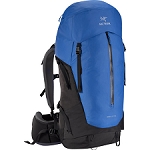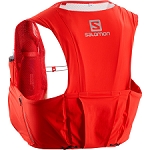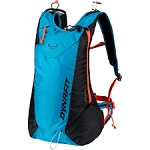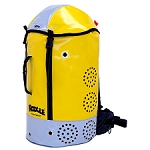Hiking, trekking, mountaineering, climbing, skiing, canyoning, children, large-capacity...

How to choose your mountaineering backpack; an inseparable companion
A Few Important Tips Before Getting Started
The variety of sizes, shapes, gear holders and attachments, make choosing a backpack no easy task. In this article, we will give some tips to help choose the right one for you.
Let's start by observing a general rule that is sometimes ignored, when looking for a lightweight pack, but which can lead to serious problems in the mountains:
- First Think about the activity the backpack will be used for (duration, level of technicality, place and time of year)
- Then list which equipment is essential for this activity, both technical and precautionary (for example, always carry a warm, waterproof garment, whatever the season).
- Finally, choose the most suitable backpack for the activity in question, bearing in mind that the equipment on your list must fit.
Because of the risks involved, we recommend following the rules in this order, not the other way round (unfortunately, this is quite common). It is no good choosing a small, light pack for lightweight comfort and then only packing the items that can fit, leaving out essential safety equipment.
Neither do we recommend the opposite extreme, which would mean filling the backpack with things you don’t need, just because there’s space in the pack.
It is clear then, that ONE BACKPACK FOR ALL, DOES NOT EXIST. Providing the capacity is right, most backpacks can be used for a wide range of activities, even if designed for a specific use, but clearly you would not use the same pack for trail running as for a winter climb on a north face with bivouac included.
Similarly, if your only criteria for choosing a backpack is that it has to be the lightest one available, you may be disappointed with your choice. Most of us want to find a pack that is as light as possible, but if this affects the design of the waist belt, backrest and shoulder straps, it will be counter-productive: A well-designed large-capacity pack will distribute the weight of the load, so that it feels lighter. If a backpack is poorly designed or does not have a decent waist belt or shoulder straps, the load will feel heavier and more unbalanced than if you were carrying the same load in a heavier pack with better features and design. Every gram counts, but weight should be reduced by using lighter gear, not by making structural cuts.
1. Structural Parts of a Backpack
The 3 fundamental parts of a backpack are the waist belt, the back panel and the shoulder straps, in that order.
1.1. The Waist Belt
Many people mistakenly think the load should rest on the shoulders. It shouldn’t: at least 75 to 85 percent of the weight should fall on the waist belt.
For this reason, the waist belt design must fit your anatomy perfectly, and its design should not skimp on the construction. A belt with poor support, or a poor fit, will cause greater fatigue, imbalance and insecurity and your back will suffer unnecessarily.
Very small backpacks, both for hiking and trail running, have no need of a waist belt because they are designed to carry a light load of just 2-3 kilos. These packs are not designed to withstand a heavier load.
Some climbing and mountaineering technical packs minimize the waist belt, to make them compatible with a harness and to maximize movement. We will discuss these packs later.

Waist belt, back panel and shoulder straps on the Deuter Aircontact 60+10 W
1.2. Shoulder Straps
They should be anatomical, to adapt to your body shape.
Thanks to new designs, using the latest high density materials, packs are now less bulky and offer superior comfort. Another benefit is that shoulder straps no longer impede athletic movement. The greater the capacity of a backpack (and the weight of the load), the more padded and bulkier it will usually be.
1.3. Back Panel and Frame
This is essential as it offers comfort and protection and fulfils its load securing function. It provides the right amount of rigidity to the system, so that the load stays put and the pack is compact. It also protects your back and prevents objects from digging in and causing pain. Many models feature a rigid frame.

Ultra-light inner aluminium frame on the Gregory Alpinisto 50
A classic problem with backpacks is the heat and sweat they cause. Nowadays, all quality backpacks feature ventilation channels and are made of sweat-absorbing materials to minimize this problem.
The optimum solution is achieved by making space between your back and the back panel. This system was invented by Deuter (Aircontact technology) and can also be found in Lowe Alpine (Airzone) packs and some other brands. The back panel is separated from your back, completely avoiding contact and allowing total air flow.

Lowe Alpine AirZone System
2. Anatomical Factors for Selecting a Backpack
2.1. Size
For a pack to fit correctly, the waist belt, shoulder straps and backrest need to be the right size for your anatomy. It is understandable that one backpack will not provide the same fit to every person, and for this reason sizes are required. When we talk about sizes, we are not referring to the capacity and load capacity of the backpack, but to the anatomy of the back panel.
The size usually refers to torso length, however, the width and, more importantly, the length of the waist belt also vary proportionally. When choosing a backpack the waist belt should provide more than the required length to fit around your waist / hips, so that there is ample room for adjustment.
Not all backpacks vary in size, and those under 30 litres are unlikely to offer different sizes, unless they are very technical. Large-capacity backpacks, however, often feature adjustable back panels that can be adapted to different body sizes and torso lengths.

Gregory Baltoro 75, with options for M and L torso lengths
2.2. Men’s vs. Women’s Packs
Since such a large part of the load falls on the waist belt, it is essential that the waist belt offers an anatomical fit and for this reason brands now manufacture models for both men and women.
These are the main differences between men and women’s models:
- The waist belt on women's models is usually slightly wider and lies at an angle so that it rests naturally on more curved hips.
- The shoulder straps are slanted, to avoid the chest.
- The back panel is usually slightly shorter, as women’s hips are generally higher.

Arc'teryx Bora backpack for women. Shoulder straps and waist belt have a different design to the men

Arc'teryx Bora for men.
3. Backpacks According to Capacity
As we mentioned earlier, the size you select will depend on the activity and the material you need to carry. The following backpack sizes are suitable for trekking and mountaineering:
- Under 20 litres: unless specifically designed for activities, such as trail running. This small size works well for summer hiking, where you don’t need much gear. As this size is designed for a light load, it may not have a waist belt. A 20L pack is not recommended for mountaineering as it is unlikely to be large enough to hold the required gear.
We also include the Daypack in this section. Daypacks, as their name suggests, are designed to be used for day activities and are also suitable for urban use. They are very versatile and are also popular as hand luggage.

CAMP Ghost 15 litres
- 20-35 litres: These multi-purpose packs are perfect for day activities, especially in warmer weather when you don't need much warm clothing. This size often has a waist belt, but it is still a minimalist pack, as the load is still small.

Deuter Guide Lite 28 litres W, women’s model
- 40-65 litres: The most common size used for outdoor activities. The waist belt is an important feature. Originally designed for overnight activities or long treks with overnight stays in mountain huts, where only a lightweight sleeping bag is required.
In recent years, thanks to the advancement of materials, the volume and weight have hugely improved and it is now possible to carry a large pack with a capacity of 50-55-60 litres packed with warm sleeping bags, stoves, warm clothes, etc. Nowadays, the latest stove with kitchenware can occupy and weigh less than a quarter of what it would have weighed 20 years ago. The same goes for bags, tents and ultralight clothing. For this reason, the large-capacity pack is currently the most popular for all kinds of multi-day trekking activities.
Highly versatile. This is a great pack for most mountain activities and can even be used for day trips, even though it is not specifically made for this purpose, by adjusting the straps to fit the inner volume.
Side compression straps are an essential part of any backpack as they allow you to adapt the capacity to the load, keeping it balanced and stable. This way you can safely carry a half-loaded backpack.

Millet Ubic 50 +10 W for women
- Over 65 litres. These are the largest backpacks and their capacity can go up to 100 litres. Designed for extended treks or expeditions and base camp approach, they feature an oversized back panel, frame and waist belt to achieve maximum carry comfort and minimize the feeling of weight.
Until some years ago these packs were the only choice for self-sufficient, multi-day treks, but nowadays, a 45-65 litre pack is often large enough. Remember to stick to the general rule: only choose a backpack between 45-65 litres for a trek if all the essentials fit; if not, choose a cargo pack.
Never leave important gear behind just because the pack is too small and never carry more than necessary just because you have the space.

Vaude Skarvan 70+10
4. Backpacks According to Activity
4.1. Backpacks for Technical Mountaineering
When choosing a technical mountaineering pack, carry comfort or an ergonomic waist belt may not always be your top priority.
It is more important that climbing or mountaineering packs allows freedom of movement and this often means sacrificing a certain amount of comfort.
- A minimum waist belt.
- A narrower backpack design, so that it does not inhibit arm movement, although this makes it harder to fit gear into the narrower space.
- The waist belt is compatible with a harness.
- The shoulder strap design, like the waist belt, is minimized to allow arm movement.
This type of backpack is still versatile, and can be used for many activities. The design is based on a mountaineering pack, unlike pure climbing backpacks, which are redesigned from scratch.
A mountaineering backpack will normally feature attachments for skis, ice axe, rope, probe and shovel. The lumbar area and waist belt can sometimes be removed to make them lighter and less bulky for climbing or for use as a summit pack.
Black Diamond Distance 15.
A new concept for a summit pack
The Black Diamond Distance 15 from 2019, is a hybrid pack that takes the design of a trail running hydration vest, and adapts it for mountaineering by using the same materials (fully waterproof) and carry systems: (ice axe and pole holders).
The result is a very light, ergonomic backpack that feels as if the load is part of your body, which gives exceptional performance in fast, technical situations.

Black Diamond Distance 15
4.2. Climbing Packs
Very specific packs where the features of a mountaineering pack are taken to the extreme:
- Minimalist, easy to remove waist belt.
- The design sits higher on the back and the narrow tube shape has a smaller base. Both features allow easy access to the material at the back of the harness.
- Back panel is minimized to the extreme.
These backpacks, together with smaller capacity mountaineering packs are sometimes called summit packs and are often combined with larger packs: a 40-50 litre pack (or larger) is used for the approach or trek, while the summit pack is used as a lighter pack for the final push to the summit.
The latest models are very ingenious for this purpose. For example, the Cassin Eghen 22, folds in on itself after the backrest is removed (also foldable), so that it can be attached to the outside of the larger backpack. As it features daisychains and other attachments for your rope, ice axe, helmet, and so on, it is perfect as a summit pack.
Backpacks for both mountaineering and climbing are often fitted with a haul loop so that they can be hauled up a wall.
4.3. Trekking and Mountaineering Backpacks
The most common and versatile, some are purely for hiking, others are more technical, but the vast majority are similar to a mountaineering pack in terms of the attachments for your ice axe, poles, etc, but without the technical, narrow design of climbing packs that inhibits the load.
How to Choose Your Backpack for Mountaineering, Hiking and Trekking
4.4. Trail Running Packs
This is another world. For this reason we talk about this category in a separate article:
How to Choose your Trail Running Pack or Belt
4.5. Ski Backpacks
Many mountaineering backpacks feature ski holders, but we are going to talk about ski backpacks specifically designed for ski mountaineering competition and regular back country ski excursions.
Some models are purely for competition and are reduced to the minimum expression, while others are designed for free-ride or ski touring. These types of backpacks generally do not exceed 30-35 litre capacity, and feature attachments for carrying a probe, shovel, skis, etc.
4.6. Canyoning Packs
Made of durable, water-resistant materials, they are designed specifically for canyoning. Featuring drainage holes and quick-release straps to escape from a whirlpool . As these features are essential for your safety, it is not advisable to use another type of backpack for canyoning.
4.7. Baby Carriers
Although its use is obvious ,we mention baby carriers because, those designed for mountain use comply with certain safety and protection standards that ensure maximum safety when hiking, both for the user and the baby. They also include a compartment for carrying essential items.
Baby carriers allow you to safely experience magical moments with your little ones, initiating them in the wonders of the outdoors and mountains.
4.8. Daypacks and Travel Packs
These are not technical backpacks, but classic urban backpacks for travel, etc.
Those made by mountain brands are usually manufactured with the same quality requirements as mountaineering backpacks, and feature a good back panel.
They are versatile, and 25-35 litre models are perfect for day hikes.
5. Backpack Accessories
Depending on the use, the number of accessories will vary. From the most minimalist pure hiking packs, which may feature just a couple of pole holders, to the more technical packs with numerous accessories.
While we do not advise buying a backpack with a multitude of attachments you will not use (straps and attachments can snag), most trekking and mountaineering backpacks include the right amount of attachments for use in a wide range of non-technical activities (with ice axe holders, pole holders, daisychains for material, etc.).
- Ice-axe holder
- Pole holder
- Ski holder
- Rope holder
- Helmet holder
- Probe holder
- Shovel holder
- Gear holder (DaisyChain, rings)
- Crampon holder
- Holder for GPS and camera on shoulder strap
- Rain cover
6. Hydration Systems
Some hydration packs are specifically designed for cycling or trail running and only have room for a reservoir and no extra room for equipment. But most hiking, trekking, mountaineering and climbing backpacks include an inner hydration sleeve in the back panel for your reservoir, as well as an outlet for the tube, so that you can hydrate on the go without having to stop or remove the backpack.
This system is not a specific feature found in a certain kind of pack. Hydration systems can be featured in all backpacks, from small to large capacity or from hiking and mountaineering to skiing so that anyone who prefers the convenience of a hydration system in the mountains can rely on this technology at all times.

























Leave a comment
Be the first to comment on this article.